What is Pile Foundation?
A pile foundation, a type of deep foundation, is a thin column or long cylinder composed of concrete or steel used to support the structure and transfer the load at the necessary depth by end bearing or skin friction.
Pile foundations are typically utilized for large structures and when the shallow depth soil is insufficient to resist excessive settlement, uplift, and other issues.
Uses of Pile Foundation:
In the following circumstances, piling foundations are preferred.
- The superstructure’s load is heavy, and it’s distributed unevenly.
- Water pumping from open trenches for shallow foundations is challenging and expensive.
- The bearing capacity of the topsoil is low.
- The water level in the subsoil is high, so
- The water level in the subsoil varies dramatically.
- Timbering the trenches is tough and expensive.
- The character of the topsoil is expansive.
- The structure is located along the water’s edge or in a riverbed, vulnerable to scouring.
- Near the foundation, canal or deep drainage lines escape.
- The foundation of transmission towers, an off-shore platform vulnerable to uplift forces, is made of piles.
Selection of Pile Foundations:
When choosing the kind of pile foundation to use, consider the following factors:
- Structure’s Nature
- Condition of Loading
- Pile’s weight
- Pile’s Durability
- Funding availability
- Types of soil and their qualities Availability of materials and equipment
- The water table in the ground
- Pile Pricing
- A case study of a nearby structure
- Pile-driving facilities are provided.
- Maintaining the Pile
- Pile length is required.
- Pile Numbers Required
- Problems with pile driving
Types of Pile Foundation:
The types of piling foundations utilized in construction are as follows:
A. Based on Function:
1. End Bearing Piles:
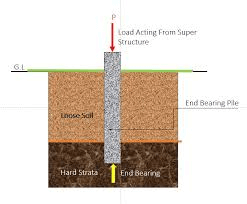
Fig 1: End Bearing Pile
Courtesy: Prodyogi.com
The loads pass through the lower tip of the pile in this type of pile. The bottom of the pile is supported by a thick layer of soil or rock. The pile usually lies atop a weak and strong slayer’s transition layer. As a result, the pile serves as a column to safely transfer the load to the strong layer.
The total capacity of an end-bearing pile is estimated by multiplying the area of the pile’s tip by the bearing capacity of the soil at the pile’s resting depth. The diameter of the pile is determined using an appropriate safety factor.
2. Friction Pile:
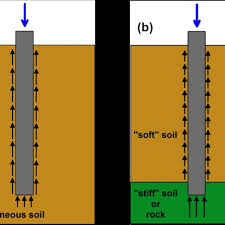
Fig 2: Friction Pile
Courtesy: researchgate.net
When a structural foundation has loose soil, friction piles are extended to a depth where the frictional resistance on the piles’ sides equals the weight applied to the piles. A friction pile is usually used when firm foundation strata are available at a deeper depth.
3. Compaction Pile:
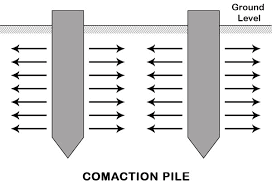
Fig 3: compaction Pile
Courtesy: civiconcepts.com
Compaction is a technique for compacting loose granular soil to increase its bearing capacity. The compaction piles do not support any weight. As a result, they may be made of a weaker substance, such as sand. The pile tube is gradually removed to compact the soil, and sand is put in its place, making a sand pile.’
3. Load Bearing Piles:
The primary purpose of this kind of pile foundation is to transfer vertical loads from the structure to the soil. These foundations transfer loads from a layer capable of sustaining the load to a layer with weak supporting properties. Load-bearing piles can be further classified as flowing based on the technique of load transmission from pile to the soil.
4. Tension Pile:
These pile foundations stabilize structures prone to uplift due to hydrostatic pressure or overturning. It’s also known as an uplift pile.
5. Fender Pile:
These piles are used to protect waterfront structures from being damaged by ships or other floating items.
6. Anchor Pile:
This pile protects horizontal pull from sheet piling or other pulling forces.
7. Sheet Pile:
They are utilized as bulkheads or impermeable cutoffs to reduce leakage and stress under hydraulic structures.
B. Based on Materials and Compositions:
1. Precast Concrete Piles:
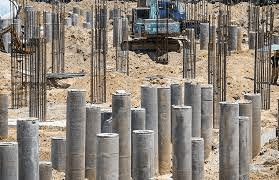
Fig 4: Precast Concrete Piles
Courtesy: nationalpilecroppers.com
Except for massive pre-stressed piles, precast concrete piles are generally utilized for a maximum design load of around 80 tonnes. To survive handling loads, they must be strengthened. They necessitate storage and casting space, additional time for setting and curing before installation, and heavy equipment for driving and managing. They also have to pay a lot of money to take off the extra length or add more distance.
2. Cast-in-Situ Concrete Piles:
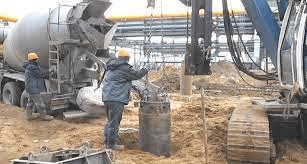
Fig 5: Cast-in-situ Concrete Piles
Courtesy: theconstructor.org
A bore is bored into the soil by placing a casing in the cast-in-situ concrete pile. After inserting any steel reinforcement, the bore is filled with concrete. The casing can either be left in place or removed. Cast-in-situ concrete piles with casing are known as softened cast-in-situ concrete piles. Uncased cast-in-situ concrete piles are those that do not have a casing.
3. Under- reamed Piles:
The under-reamed pile is a bored pile with a larger bulb or diameter at some point along its length to anchor expansive foundation soil subjected to alternate contraction and expansion.
4. Timber Piles:
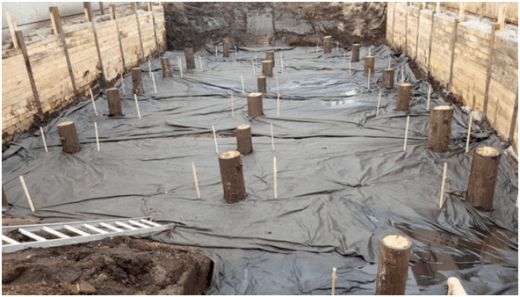
Fig 6: Timber Piles
Courtesy: civiconcepts.com
Tree trunks are used to make these mounds. They might be square or circular. These woodpiles have a diameter of 30 to 50 cm and a length of no more than 20 times their top width.
A cast-iron shoe is given at the bottom, and a steel plate is fixed at the top. When driving a collection of timber piles, the tops of each pile are brought to the same level, and then a concrete cap is added to create a shared platform. Types of pile foundations have a lower carrying capacity and, unless treated, are not permanent.
5. Steel Piles:
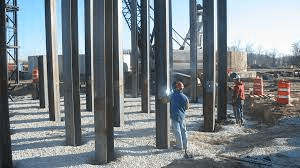
Fig 7: Steel Piles
Courtesy: shortspansteelbridges.org
Steel piles might be hollow pipe or I-section. Concrete is used to fill them. The diameter can range from 10 to 24 inches, while the thickness is usually 34 inches. The piles are simple to drive due to their tiny sectional area. End-bearing piles are the most common application.
i) H-piles:
The large flage sections of these pile foundations are common. They are appropriate for trestle structures with piles that extend above ground level and serve as columns. Because they have small cross-sectional areas, they can be easily driven in soils where standard displacement piles would be difficult to drive. They’re used as lengthy, high-bearing-capacity piles.
ii) Tube piles:
Steel tubes or pipes are driven into the earth in this form. The tube piles are filled with concrete. They’re easy to handle and drive in because of their circular mounds. These sorts of piling foundations are simple to handle and install in cross-section.
iii) Box Piles:
They are filled with concrete and are rectangular or octagonal. When driving He-piles into hard strata is not practical, certain forms of pile foundations are employed.
6. Composite Piles:
Composite Heaps are piles made of two different materials driven one on top of the other to serve the same purpose as a single pile. The beneficial properties of both materials are taken advantage of in such a combination. These are cost-effective because they combine the high corrosion resistance of one material with the low cost or strength of the other.
C. Based on Installation Method:
i) Driven Piles:
The tops of these piles are usually hammered into the soil for forced insertion. Precast concrete, timber, and steel piles are generally forced into place by driving, which can be done vertically or incline.
ii) Driven and Casts-in—Situ Piles:
These pile foundations are made by driving a casing into the soil with a closed bottom end. Concrete is then poured into the casing. The casing could be withdrawn or not. It is called an uncased Pile if the casing of the pile is not removed, and it is called a cased Pile if the casing is not withdrawn.
iii) Bored and Cast-in-Situ Piles:
Excavate a hole in the earth and fill it with concrete to create these types of piling foundations.
iv) Jacked Piles
Piling foundations are hoisted using a hydraulic jack to apply a downward push into the surface.
v) Screw Piles:
The soil is screwed into these types of piling foundations.
Advantages of Pile Foundation:
- The piles can be prepared ahead of time-based on their length.
- It may be placed across a huge region and for very long distances.
- Precasting shortens the time it takes to complete a project.
- We can employ heaps in situations where drilling isn’t necessary.
- The heaps are well-kept and tidy.
Disadvantages of Pile Foundation:
- When driving through the stones and rocks, a pile is immediately damaged.
- When the piles are driven, vibrations are produced, which damage the nearby structures.
- Marine borers can attack pilings in saltwater.
- A pile cannot be higher than the earth.
- Operating piles necessitates the use of heavy machinery.
- Drainage is not an issue with piles.
Conclusion:
The purpose of any foundation is to safely support and transfer the load from the superstructure to the ground. The intensity of the load from the superstructure and the subsoil’s nature influence the type of foundation. We must keep in mind that simple footings are the most cost-effective foundation in most circumstances.
When there are overly strong gravity loads, A pile foundation is preferred when lateral stresses are exerted over weak soil; a pile foundation is preferred. It will be easier to choose the proper form of pile foundation after examining all of the elements.
References:
1. Different types of Pile foundation and their use in construction. (2020, September 26). Constro Facilitator; www.constrofacilitator.com. https://www.constrofacilitator.com/different-types-of-pile-foundation-and-their-use-in-construction/
2. Desai, R. (2016, April 27). Pile Foundation: Types & its Classifications. GharPedia; gharpedia.com. https://gharpedia.com/blog/pile-foundation-types-classifications/
3. What is Pile Foundation? Types of Pile Foundation – Civil Engineering. (n.d.). What Is Pile Foundation? Types of Pile Foundation – Civil Engineering; civiltoday.com. Retrieved March 24, 2022, from https://civiltoday.com/geotechnical-engineering/foundation-engineering/deep-foundation/176-pile-foundation-definition-types
4. Mahajan, B. (2020, August 1). Pile Foundation | Types Of Pile Foundations | Uses Of Pile Foundation. Civiconcepts; civiconcepts.com. https://civiconcepts.com/blog/types-of-pile-foundations
5. Singh, S. (2020, June 25). Different Types Of Pile Foundation Used In Construction. Civil Engineering Web; www.civilengineeringweb.com. https://www.civilengineeringweb.com/2020/06/types-of-pile-foundation-based-on-function-use-material.html
6. What is Pile Foundation? Its Types, Uses, Design. (2018, December 19). Civil Seek; civilseek.com. https://civilseek.com/pile-foundation/
7. https://www.constrofacilitator.com/different-types-of-pile-foundation-and-their-use-in-construction/
8. https://gharpedia.com/blog/type-of-pile-foundation/
9. https://civiltoday.com/geotechnical-engineering/foundation-engineering/deep-foundation/176-pile-foundation-definition-types
10. https://gharpedia.com/blog/type-of-pile-foundation/
11. https://civiconcepts.com/blog/types-of-pile-foundations
If you have a query, you can ask a question here.


